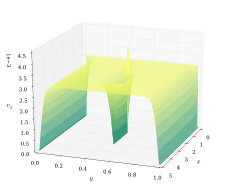Integrating factor
| Differential equations | |||||
|---|---|---|---|---|---|
 Navier–Stokes differential equations used to simulate airflow around an obstruction. | |||||
| Classification | |||||
|
Types
|
|||||
|
Relation to processes |
|||||
| Solution | |||||
|
General topics |
|||||
In mathematics, an integrating factor is a function that is chosen to facilitate the solving of a given equation involving differentials. It is commonly used to solve ordinary differential equations, but is also used within multivariable calculus when multiplying through by an integrating factor allows an inexact differential to be made into an exact differential (which can then be integrated to give a scalar field). This is especially useful in thermodynamics where temperature becomes the integrating factor that makes entropy an exact differential.
Use in solving first order linear ordinary differential equations
Integrating factors are useful for solving ordinary differential equations that can be expressed in the form
The basic idea is to find some function , called the "integrating factor," which we can multiply through our DE in order to bring the left-hand side under a common derivative. For the canonical first-order, linear differential equation shown above, our integrating factor is chosen to be
In order to derive this, let be the integrating factor of a first order, linear differential equation such that multiplication by transforms a partial derivative into a total derivative, then:
Going from step 2 to step 3 requires that , which is a separable differential equation, whose solution yields in terms of :
To verify see that multiplying through by gives
By applying the product rule in reverse, we see that the left-hand side can be expressed as a single derivative in
We use this fact to simplify our expression to
We then integrate both sides with respect to , firstly by renaming to , obtaining
Finally, we can move the exponential to the right-hand side to find a general solution to our ODE:
In the case of a homogeneous differential equation, in which , we find that
where is a constant.
Example
Solve the differential equation
We can see that in this case
- (Note we do not need to include the integrating constant - we need only a solution, not the general solution)
Multiplying both sides by we obtain
Reversing the quotient rule gives
or
which gives
General use
An integrating factor is any expression that a differential equation is multiplied by to facilitate integration and is not restricted to first order linear equations. For example, the nonlinear second order equation
admits as an integrating factor:
To integrate, note that both sides of the equation may be expressed as derivatives by going backwards with the chain rule:
Therefore
This form may be more useful, depending on application. Performing a separation of variables will give
This is an implicit solution which involves a nonelementary integral. This same method is used to solve the period of a simple pendulum.
References
- Munkhammar, Joakim, "Integrating Factor", MathWorld.
See also
- Method of variation of parameters
- Examples of differential equations
- Product rule
- Exact differential
- Matrix exponential - for integrating factors for systems of n first order linear equations in n variables